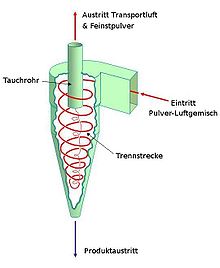Inertia separator
A mass force separator or mass force deduster is an apparatus for separating particles or dusts due to inertia forces. Mass force separators are characterized by low investment and operating costs as well as great reliability and are preferably used for coarse dedusting in exhaust gas cleaning.
Working principle
The operating principle of inertial force separators is based on the fact that the particles suspended in the gas can no longer follow the flow movement and are deposited on built-in components or walls. They are differentiated according to the effective transport forces
- Gravity ,
- Inertial force and
- Centrifugal force .
The inertial forces responsible for particle separation act across or against the flow resistance force and are directly proportional to the particle mass, so that the respective forces are proportional to the third power of the particle diameter.
Mass force separators are preferably used to separate particles with an aerodynamic diameter of at least 2 µm. With particles of this size, the influence of diffusion can be neglected.
The principle of mass force separation is also often used in wet separators , in that the total particle mass is increased by the accumulation of dust particles on water droplets.
Embodiments
Gravity separator
Gravity separators are usually designed as so-called cross-flow or counter-flow separators . The dust-laden gas flow is slowed down as it enters the apparatus and thus the dwell time in the system is increased. A relative movement of the particles transversely to the direction of flow (cross-flow separator) or against the direction of flow (counter-flow separator) causes them to be partially separated.
Centrifugal separator
In the case of cyclone or centrifugal separators , the flow is set in rotation due to its own speed after entering the apparatus. The particles suspended in the gas are partially separated as a result of the centrifugal force acting on them .
Inertial separator
In inertial or deflection separators, flows are deflected in such a way that the particles suspended in the gas cannot follow the flow movement and are separated. To this end, obstacles are often built into the separator.
literature
- VDI 3676: 1999-09 Inertial Separators. Beuth Verlag, Berlin. ( Summary online , table of contents )
Individual evidence
- ^ A b Günter Baumbach: Air pollution control . Springer-Verlag Berlin, Heidelberg, New York, 2nd edition 1992, ISBN 3-540-55078-X , pp. 314-318.
- ^ Franz Joseph Dreyhaupt (editor): VDI-Lexikon Umwelttechnik . VDI-Verlag Düsseldorf, 1994, ISBN 3-18-400891-6 , p. 792.
- ↑ Matthias Stieß: Mechanical Process Engineering 2 . Springer-Verlag Berlin, Heidelberg, New York, 1994, ISBN 3-540-55852-7 , p. 5.
- ↑ Ekkehard Weber: Status and goal of basic research in wet dedusting . In: Dust - cleanliness. Air . 29, No. 7, 1969, ISSN 0949-8036 , pp. 272-277.
- ↑ VDI 2264: 2001-07 Commissioning, operation and maintenance of separator systems for the removal of gaseous and particulate substances from gas streams (Commissioning, operation and maintenance of separator systems for the removal of gaseous and particulate substances from gas streams). Beuth Verlag, Berlin, p. 27.
